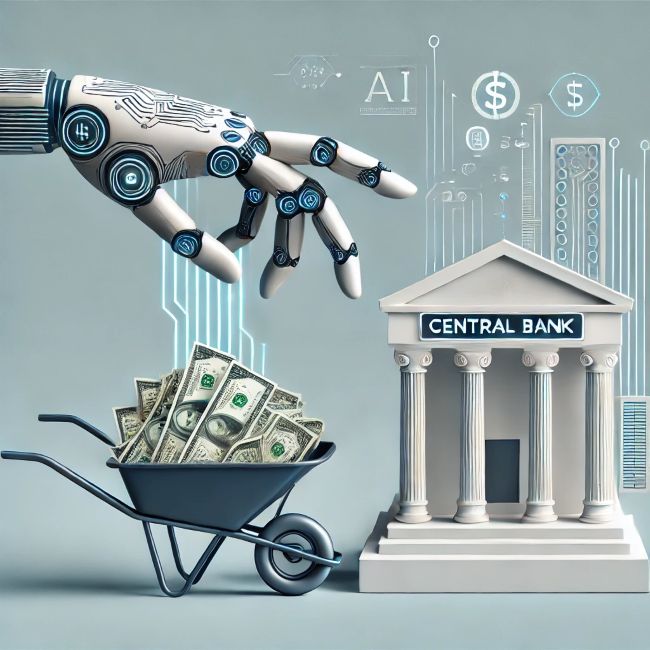This piece peers into possibilities, not predictions—think of it as a thought experiment, not a playbook.
Hyperinflation—when prices soar past 50% a month—has long tested economies, leaving behind tales like Weimar Germany’s overflowing cash carts or Zimbabwe’s trillion-dollar notes turned to kindling. Could modern tools offer a fresh lens on this challenge? Artificial Intelligence (AI) and Central Bank Digital Currencies (CBDCs) are emerging as ideas that might help central banks navigate extreme inflation. Let’s explore how they could contribute, where they might fit, and what considerations they bring—no definitive answers, just a peek at the potential.
The Concept: AI and CBDCs in the Inflation Toolbox
CBDCs are digital takes on national currency, issued and managed by central banks—a controlled twist on cash, unlike the free-range nature of cryptocurrencies like Bitcoin. Combine that with AI’s knack for parsing vast data quickly, and you’ve got a duo that could sharpen a central bank’s view of the economy. Together, they might enhance monitoring, refine policy adjustments, or adapt to inflation pressures more smoothly than older approaches.
The possibilities are intriguing. CBDCs could deliver a steady flow of transaction data, offering a clearer picture of economic trends. AI might then sift through that data to highlight patterns or propose tweaks, potentially easing volatility. As of March 2, 2025, ongoing global pilots are testing these ideas, though they’re still in early stages.
How They Might Work Together
What roles could AI and CBDCs play in managing inflation—or even broader economic flows? Here’s a look at their potential mechanics:
- Enhanced Data Insights: CBDCs could capture spending shifts instantly—say, a rise in fuel costs—giving central banks a live feed rather than delayed reports. AI might analyze this, possibly crafting daily inflation snapshots from routine transactions. It’s about spotting what moves prices, from supply hiccups to demand swings.
- Adaptable Money Flows: CBDCs could let banks adjust the money supply with finesse—adding digital funds to juice up demand or trimming them to temper excess. Concepts like negative interest rates on digital wallets, beyond paper cash’s reach, have been floated. It’s a way to balance circulation, perhaps steadying choppy waters.
- Customizable Options: CBDCs could carry built-in rules—imagine “bonus bucks” tied to essentials or set to expire after a month to nudge spending. Think of historical rationing echoes, but digital—AI could refine these tax tweaks based on economic signals, targeting support where it’s needed.
- Tax Collection Concepts: Some imagine CBDCs that deduct taxes straight from transactions—small slices at the point of sale, adjusted by AI to reflect conditions. It’s a theoretical nod to streamlining revenue, not a set plan.
- Local and Circular Ideas: CBDCs might channel “bonus bucks” to local merchants or recycled goods, supporting community loops. AI could track these effects, potentially fostering resilience in smaller economies. It’s a riff on keeping value close.
- System Stability: Inflation often stirs mischief—counterfeits, black markets. AI could watch CBDC flows for oddities, like sudden spikes, helping maintain confidence. It’s a subtle layer of oversight.
Where They Could Come Into Play
In times of hyperinflation—or even routine management—AI and CBDCs might find practical uses. Here’s how that could shape up:
- Ongoing Monitoring: CBDCs could stream live data, letting banks track shifts—like a retail surge or price dip—and adapt policies as they unfold. AI might offer early warnings, flagging trends like supply squeezes.
- Focused Support: CBDCs could direct “bonus bucks” to specific needs—credits for hard-hit sectors, perhaps expiring in 60 days to juice up demand. AI could pinpoint recipients, refining delivery. It’s about precision over broad strokes.
- Flow Management: To keep money from fleeing in a crisis, CBDCs might cap outflows, while steering credits to local use. AI could monitor these patterns, adjusting as needed. It’s a balance of stability and flexibility.
- Sector and Cycle Tweaks: If energy overheats, AI could detect it in CBDC data, and banks might roll out tax tweaks or credits for sustainable options. It’s a nuanced approach to equilibrium.
- Revenue and Incentive Trials: CBDCs could test ideas like deducting taxes straight from purchases or offering perks for local spending, with AI calibrating rates or reach. It’s an experimental take on fiscal flow.
The Flip Side: What’s on the Table?
No idea’s flawless, and AI with CBDCs brings points to ponder:
- Banking Shifts: If CBDCs pull funds from banks, lending might dip. It’s a debate—could it slow momentum, or will systems adjust? Time will tell.
- Data Transparency: CBDCs’ tracking power raises questions about balance—useful insights versus personal comfort. Banks are studying ways to harmonize this.
- Tech Safeguards: Digital tools need strong protection—disruptions could dent trust. It’s a resource-intensive must.
- Resource Needs: Building CBDCs and AI takes hefty investment—tech, training, energy—not every economy’s equipped yet.
- Policy Calibration: Custom features—like “bonus bucks”—require careful tuning. Too rigid, and they might chafe; too soft, and they lose effect.
Real-Life Trade-Offs
Here’s the give-and-take in brief:
| Potential Upside | Things to Weigh |
|---|---|
| Clearer data, swift shifts | Banking changes, growth queries |
| Precise aid, system trust | Transparency talks, safeguard needs |
| Flexible tools, local lift | Costs, policy fine-tuning |
Wrapping It Up
AI and CBDCs might offer central banks a new vantage point—deeper data, tailored “bonus bucks,” and ideas like tax tweaks or local credits. For some, it’s a glimpse at steadier ground amid price storms; for others, a chance to explore resilience, perhaps drawing from past lessons in Wealth Preservation in Times of War and Revolution. Considerations—like banking shifts or resource demands—are just part of the conversation, not stop signs.
With global pilots humming as of March 2, 2025, we’re watching early steps. Could this shift how inflation’s handled? It’s an open question. For more on tech’s economic dance, see How AI Can Help You Build and Preserve Wealth or The Great American Bitcoin Race. This is a view of what might be, not what must.
//
This isn’t a roadmap—check with a pro before making moves.

